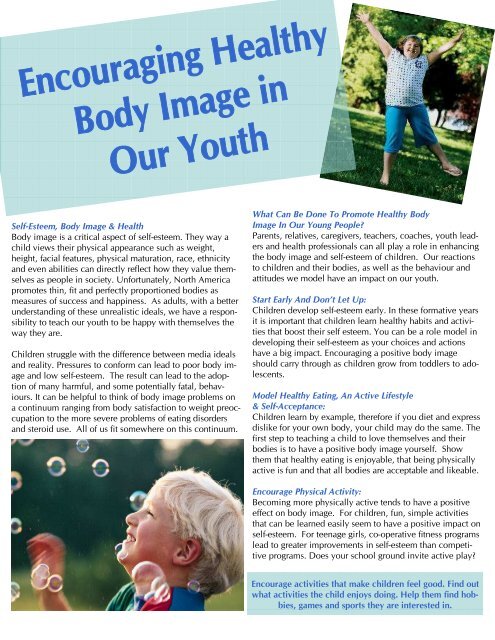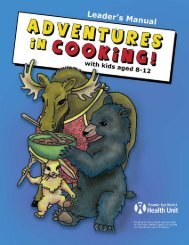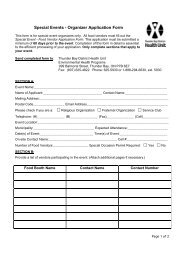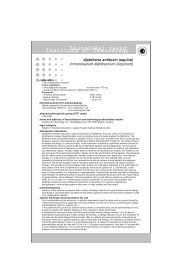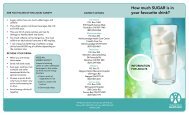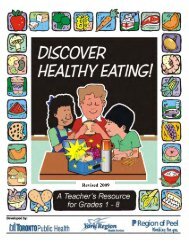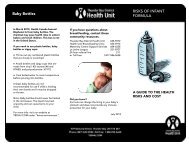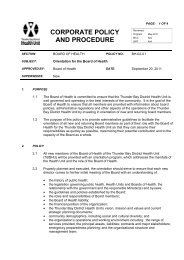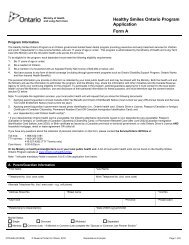Promoting a Healthy Body Image - Thunder Bay District Health Unit
Promoting a Healthy Body Image - Thunder Bay District Health Unit
Promoting a Healthy Body Image - Thunder Bay District Health Unit
Create successful ePaper yourself
Turn your PDF publications into a flip-book with our unique Google optimized e-Paper software.
Self-Esteem, <strong>Body</strong> <strong>Image</strong> & <strong>Health</strong><br />
<strong>Body</strong> image is a critical aspect of self-esteem. They way a<br />
child views their physical appearance such as weight,<br />
height, facial features, physical maturation, race, ethnicity<br />
and even abilities can directly reflect how they value themselves<br />
as people in society. Unfortunately, North America<br />
promotes thin, fit and perfectly proportioned bodies as<br />
measures of success and happiness. As adults, with a better<br />
understanding of these unrealistic ideals, we have a responsibility<br />
to teach our youth to be happy with themselves the<br />
way they are.<br />
Children struggle with the difference between media ideals<br />
and reality. Pressures to conform can lead to poor body image<br />
and low self-esteem. The result can lead to the adoption<br />
of many harmful, and some potentially fatal, behaviours.<br />
It can be helpful to think of body image problems on<br />
a continuum ranging from body satisfaction to weight preoccupation<br />
to the more severe problems of eating disorders<br />
and steroid use. All of us fit somewhere on this continuum.<br />
What Can Be Done To Promote <strong><strong>Health</strong>y</strong> <strong>Body</strong><br />
<strong>Image</strong> In Our Young People?<br />
Parents, relatives, caregivers, teachers, coaches, youth leaders<br />
and health professionals can all play a role in enhancing<br />
the body image and self-esteem of children. Our reactions<br />
to children and their bodies, as well as the behaviour and<br />
attitudes we model have an impact on our youth.<br />
Start Early And Don’t Let Up:<br />
Children develop self-esteem early. In these formative years<br />
it is important that children learn healthy habits and activities<br />
that boost their self esteem. You can be a role model in<br />
developing their self-esteem as your choices and actions<br />
have a big impact. Encouraging a positive body image<br />
should carry through as children grow from toddlers to adolescents.<br />
Model <strong><strong>Health</strong>y</strong> Eating, An Active Lifestyle<br />
& Self-Acceptance:<br />
Children learn by example, therefore if you diet and express<br />
dislike for your own body, your child may do the same. The<br />
first step to teaching a child to love themselves and their<br />
bodies is to have a positive body image yourself. Show<br />
them that healthy eating is enjoyable, that being physically<br />
active is fun and that all bodies are acceptable and likeable.<br />
Encourage Physical Activity:<br />
Becoming more physically active tends to have a positive<br />
effect on body image. For children, fun, simple activities<br />
that can be learned easily seem to have a positive impact on<br />
self-esteem. For teenage girls, co-operative fitness programs<br />
lead to greater improvements in self-esteem than competitive<br />
programs. Does your school ground invite active play?<br />
Encourage activities that make children feel good. Find out<br />
what activities the child enjoys doing. Help them find hobbies,<br />
games and sports they are interested in.
Adopt A Non-Comparative/Non-Competitive Philosophy:<br />
Self-esteem is also shaped as children compare their own<br />
characteristics and abilities to those of others. At school<br />
and at home we should emphasize personal progress instead<br />
of comparisons with others. Reward participation,<br />
effort and enthusiasm.<br />
Build their confidence and remind them they are special.<br />
Question The Media:<br />
Children, like adults, compare themselves to the media<br />
images they are bombarded with daily. Who can feel<br />
good if the ideals measured against are unattainable? Be<br />
critical when it comes to the media. Help children to understand<br />
how advertisers use these images to sell. How<br />
realistic are these ideals? What is really being sold? How<br />
are our insecurities being used for profit?<br />
Focus On <strong><strong>Health</strong>y</strong> Living:<br />
Many of the health problems associated with obesity may<br />
be, at least in part, a result of repeated cycles of weight<br />
loss and gain; failed attempts at weight loss take an incredible<br />
toll on self-esteem. Those interested in improving<br />
health and reducing risk of disease will get better results<br />
by making small changes in healthy eating and physical<br />
activity, and will last a life-time. Eat more vegetables and<br />
fruit, less junk food and more whole grain products and get<br />
active daily!<br />
Natural body sizes<br />
are the healthiest<br />
body sizes.<br />
8 Things You Can Do Now:<br />
1. Stop talking about your weight (especially in front of<br />
young people).<br />
2. Have your child make a list of people they admire and<br />
why they admire them. Show them that valuing personality<br />
is more important than valuing appearance.<br />
3. Question the motives of the media.<br />
4. Stop weighing yourself!<br />
5. Have children concentrate on the things they do well.<br />
Encourage activities that help their unique strengths<br />
flourish.<br />
5. Get the whole family physically active for fun. Don’t<br />
single out an overweight child. When all family members<br />
are involved it also helps to create a closer,<br />
healthier family.<br />
7. Be a positive role model with your attitudes, eating<br />
habits and physical activity behaviours.<br />
8. Break the barriers- emphasize fun, not skill.<br />
Together we can start to turn the tides on low-self esteem and body image problems<br />
that can eventually lead to harmful behaviours and disease. As adults we have a responsibility,<br />
individually and collectively, to challenge current beauty ideals and<br />
take action. We can act within our own families, within our schools, within our<br />
communities and within our health care services.<br />
This document was produced by Dietitians and Nutritionists at the <strong>Thunder</strong> <strong>Bay</strong> <strong>District</strong> <strong>Health</strong> <strong>Unit</strong>. May be reproduced provided source is acknowledged.<br />
For more information, contact Nutrition Promotion at the <strong>Thunder</strong> <strong>Bay</strong> <strong>District</strong> <strong>Health</strong> <strong>Unit</strong> at (807) 625-8315.<br />
N-164/2009


